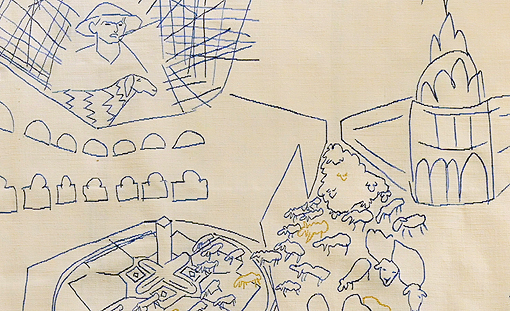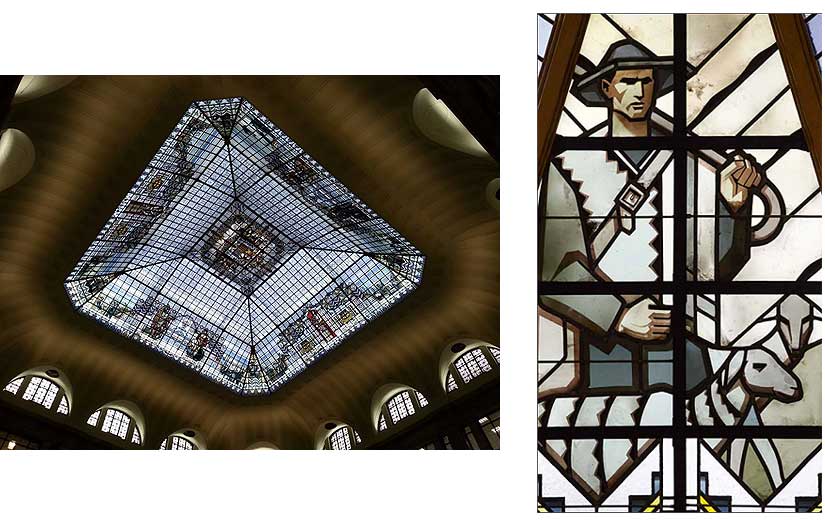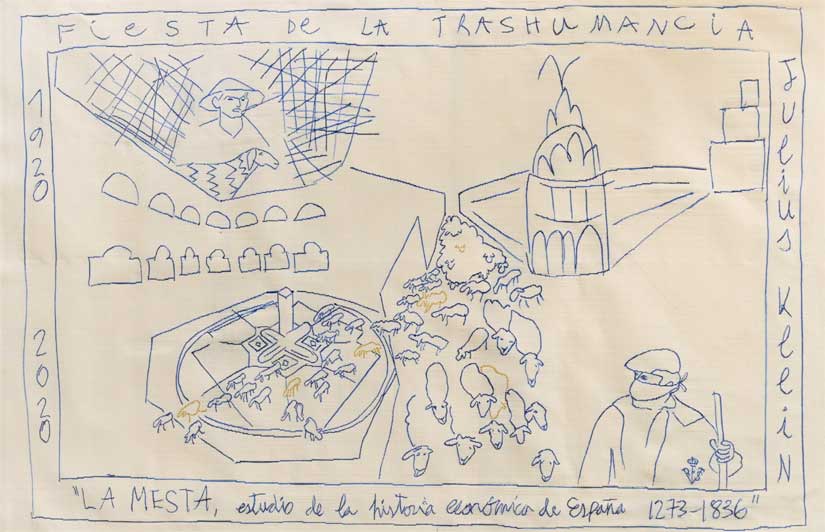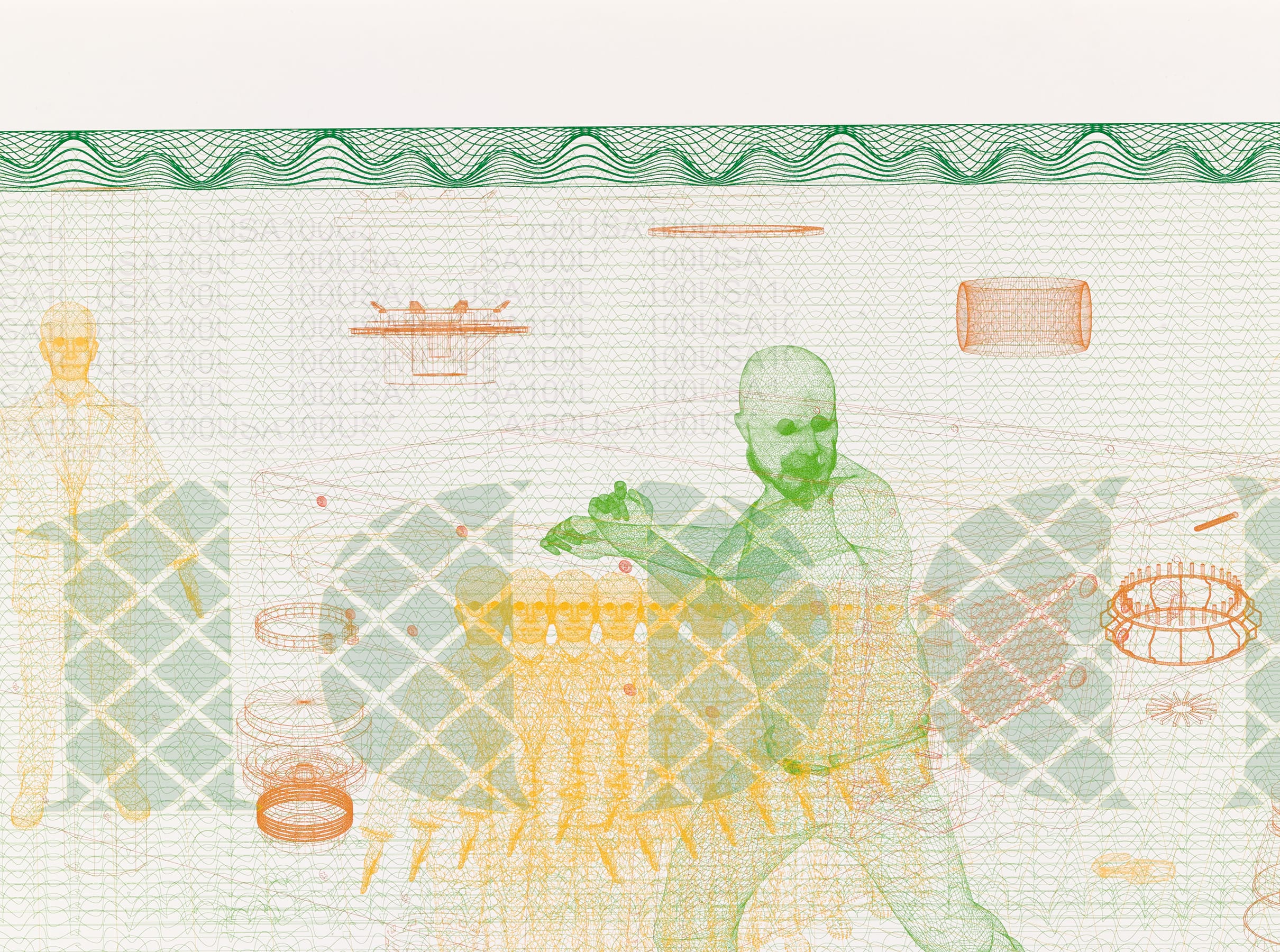
Patricia Esquivias creates tapestry linking “Mesta” and seasonal droving of livestock with history of Banco de España
This tapestry by Patricia Esquivias (b. Caracas, Venezuela, 1979), designed to look like a doodle on a serviette, was commissioned by the Banco de España. It marks the centenary of the publication of the book The Mesta, A Study in Spanish Economic History, 1273-1836 by US historian Julius Klein, and highlights Transhumance Day as a serious demand for recognition rather than just a pageant. The main setting for the scene is the Trading Floor![]() of our headquarters building at Plaza de Cibeles. Indeed, the work contains a reference to one of the most iconic decorative elements there: the Art Déco style stained glass
of our headquarters building at Plaza de Cibeles. Indeed, the work contains a reference to one of the most iconic decorative elements there: the Art Déco style stained glass![]() panels by Casa Maumejean.
panels by Casa Maumejean.
We spoke to the artist to learn more about the points of reference, reasons and purposes that influenced her in the weaving of this tapestry at the Real Fábrica de Tapices![]() mill. Her works tend to be strongly conceptual and narrative in nature, set out as critical artistic and historical research projects that blend poetry with politics.
mill. Her works tend to be strongly conceptual and narrative in nature, set out as critical artistic and historical research projects that blend poetry with politics.
 Art Déco stained glass by Casa Maumejean on the trading floor of the Banco de España | Detail of the stained glass showing a shepherd
Art Déco stained glass by Casa Maumejean on the trading floor of the Banco de España | Detail of the stained glass showing a shepherd
Patricia Esquivias explains that this is one of a group of pieces intended to echo earlier works by other artists and to re-imagine and adapt them to current circumstances. Her inspiration here came from the stained-glass panelling by Maumejean installed above the trading floor during the first extension of the central headquarters building at Cibeles in the 1930s. Under this trading floor lies the famous Gold Chamber. The panelling was designed as a decorative element illustrating the role of industry as the preferred path for progress. In one corner there is a shepherd wearing a sheepskin coat and a hat, carrying a pouch and a crook and accompanied by two sheep.
That shepherd inspired the figure in the top right part of the tapestry. Close by is a reference to The Mesta, A Study in Spanish Economic History, 1273-1836![]() by Julius Klein, which Ms. Esquivias considers to be the most extensive study ever produced on the sheep drovers' association known as the Honourable Council of the Mesta. This association ceased to exist in 1836, when Spain was beginning to industrialise. There is also a depiction of Transhumance Day, when drovers from all over Spain drive their sheep through Madrid city centre to maintain their claim to right of way along traditional livestock trails. This is an event of considerable political significance, though it is sometimes portrayed by the media as a mere pageant.
by Julius Klein, which Ms. Esquivias considers to be the most extensive study ever produced on the sheep drovers' association known as the Honourable Council of the Mesta. This association ceased to exist in 1836, when Spain was beginning to industrialise. There is also a depiction of Transhumance Day, when drovers from all over Spain drive their sheep through Madrid city centre to maintain their claim to right of way along traditional livestock trails. This is an event of considerable political significance, though it is sometimes portrayed by the media as a mere pageant.

The tapestry by Patricia Esquivias
The scene is one of considerable symbolic importance. It shows flocks of sheep emerging from Calle Alcalá onto Plaza de Cibeles on Transhumance Day and the shepherd from the stained-glass panels by Maumejean calling them into the Banco de España. The trading floor is taken over by sheep, some of them woven in gold thread in a metaphor for the time when wool was worth more than gold to the Spanish economy.
The tapestry also depicts a modern-day shepherd in a coat that bears the logo of the Real Fábrica de Tapices in Santa Bárbara, the ancient royal tapestry mill where Goya's Cartoons![]() were woven in the late 18th century, with the country scenes so dear to King Charles III of Spain. Ms. Esquivias' tapestry was also woven there. She felt that it should be produced locally, in keeping with the tradition of the art works commissioned by the bank, making good use of the proven expertise of the experts at the mill in working with Spanish wool.
were woven in the late 18th century, with the country scenes so dear to King Charles III of Spain. Ms. Esquivias' tapestry was also woven there. She felt that it should be produced locally, in keeping with the tradition of the art works commissioned by the bank, making good use of the proven expertise of the experts at the mill in working with Spanish wool.
One more striking thing about the shepherd is that he seems to be wearing an improvised face-mask, though the artist says that it could also be seen as a neckerchief. This detail highlights the unusual context in which the work was produced, in a year when Transhumance Day was cancelled for the first time since its inception in 1994. However, the piece also seeks to show the true importance of work in the countryside, which tends to be disdained and undervalued, for the sustaining and continuation of life in post-industrial societies.
